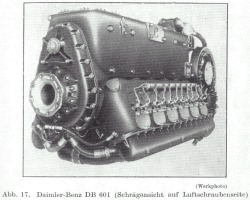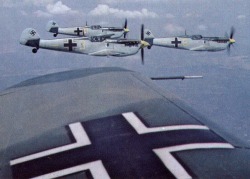|
Flying the Bf 109e
Excerpted from Flight Journal, December 1999 |
||||
|
RAF pilot Captain Eric Brown had a thirty-one year career in the Royal Navy. After the war he became Chief Naval Test Pilot at the RAE at Farnborough, England, where he served for six years. During that time he commanded the Enemy Aircraft Flight, the High Speed Flight and, finally, the prestigious Aerodynamics Flight Branches of the A&AEE. The cockpit was claustrophobic in the extreme. Once settled in the cockpit I became aware of the characteristic smell that pervaded all German aircraft; it somehow reminded me of almonds and was strong but not sickly. The reflector gunsight was very intrusive in that cramped environment and was heavily padded (obviously, for safety). The forward view on the ground was terrible, so on takeoff I was advised to raise the tail as quickly as possible. This could be done fairly abruptly without fear of the airscreen hitting the airfield surface because the inverted-vee engine's high thrust line gave ample clearance.
 The airplane had to be flown off, as any attempt to pull it off early resulted in aileron snatching, as the wing slats opened unevenly. For this reason, to shorten the takeoff run, 15 degrees of flap were recommended. Once the Bf was airborne, the main wheels retracted quickly, but the electrically actuated airscrew pitch-changing was slow. The flaps were raised manually by means of the outer of two concentrically mounted wheels to the pilot's left; the inner wheel adjusted tailplane incidence. Thus, the wheels could be moved simultaneously to counteract the trim change as the flaps came up.
 The climb was at a steep angle; stability proved excellent in the longitudinal and lateral planes and was almost neutral directionally. Control harmony was poor because the rudder was light, the ailerons moderately light and the elevators extremely heavy. Control harmony in a fight should be achieved with light ailerons, slightly heavier elevator and the rudder heaviest. An airplane's stalling characteristics tell a lot about its "inner self," and the 109 was no exception. At about 20 mph (30 km/h) above stall speed and with the aircraft "clean," the stall was preceded by elevator stick buffeting and the opening of the slats; this was accompanied by unpleasant aileron snatching as the slats opened unevenly. The stall itself was fairly gentle: the nose fell off, and the left wing dropped about 10 degrees. These characteristics were accentuated in the landing configuration. |
 The landing approach was quite steep, but elevator felt very positive, which was just as well, for a substantial change of attitude was called for in the flare before touchdown. Even after ground contact, the lift did nor spill rapidly, and on rough terrain, ballooning or bouncing were common. Flying formation was easy with the crisp ailerons, rather heavy elevators and good engine response to throttle movement. Aerobatics, however, were more difficult because of the elevator heaviness and the slats snatching at the top of loops; this was often remarked on by young student pilots captured and questioned at the end of the War, and all were critical of the aircraft's landing idiosyncrasies. (Nearly 1/3 of the entire production of Bf109s crashed on landing or takeoff). It must be remembered, however, that pilot training in Germany in WWII was neglected to an incredible degree, as the pilot schools were directly subordinate to the air fleet commanders, who regarded the instructors as reserve pilots there to top off frontline units. The effect was that by 1944, Luftwaffe fighter pilots were being sent into combat with only 160 hours flight time whereas their British and American counterparts had 360 and 400 hours, respectively. I was not overly impressed with the Emil, and yet it has earned a considerable reputation in the eyes of many aviation historians. This reputation rests mostly on its superiority to the mediocre - and often downright inferior - opposition, especially on the Eastern Front.... I know only too well how easy it is to get emotionally involved with an airplane in which you have fought and survived... But, when you've flown a wide range of other fighters your views are soon tempered by reason. Certainly the Bf109 was a good workhorse, but it was not a thoroughbred like the Spitfire and Mustang. To order Flight Journal click the image.
 Join a discussion forum on this article by clicking HERE.
|
|||
|
Copyright © 1997 - 2000 COMBATSIM.COM, INC. All Rights Reserved. Last Updated November 6th, 1999 |
||||
